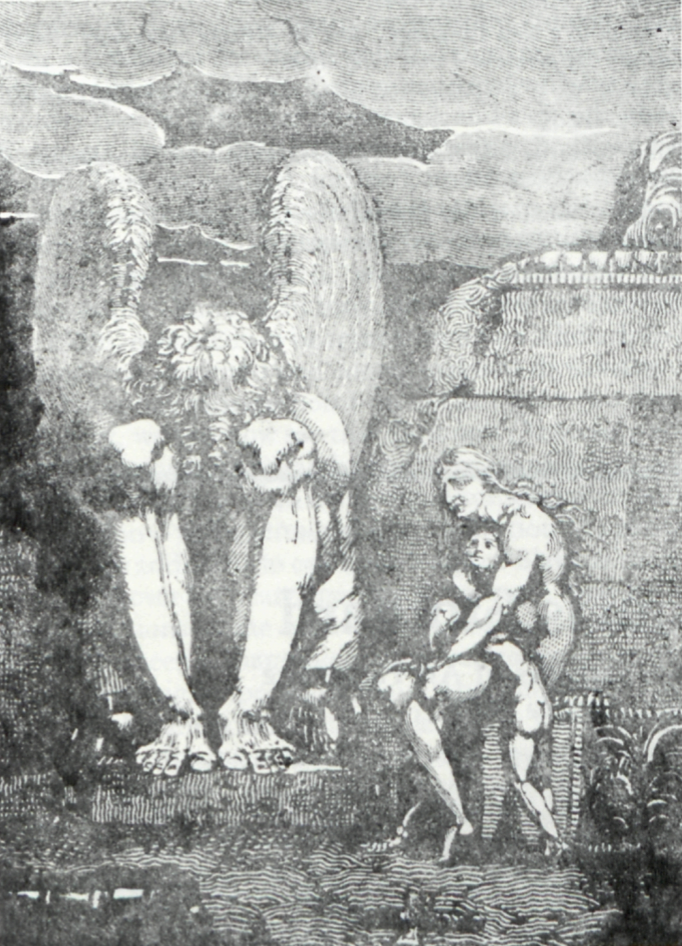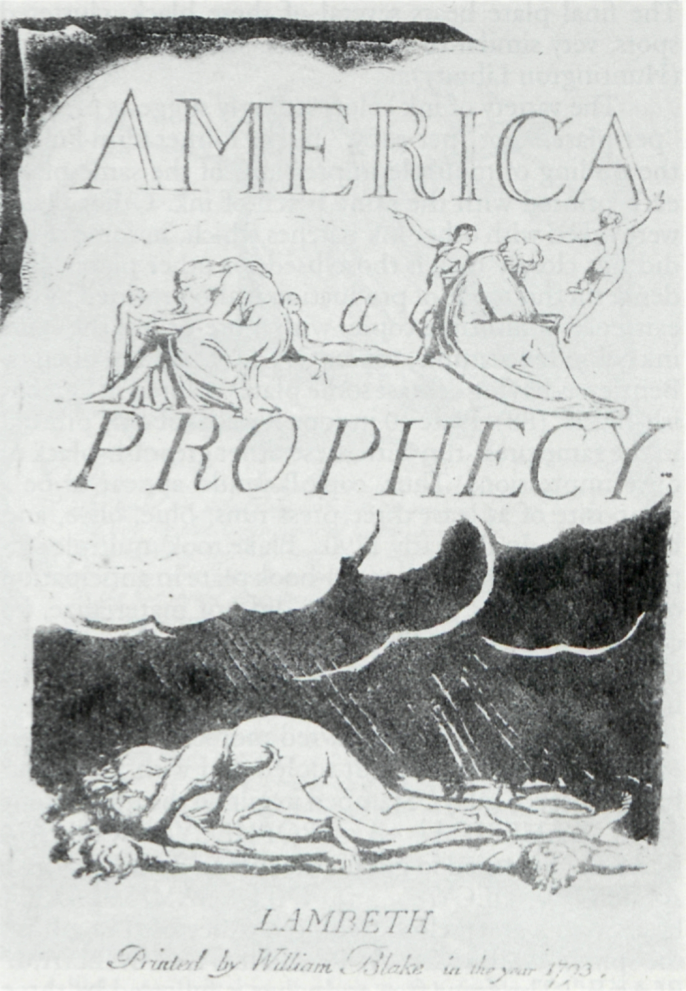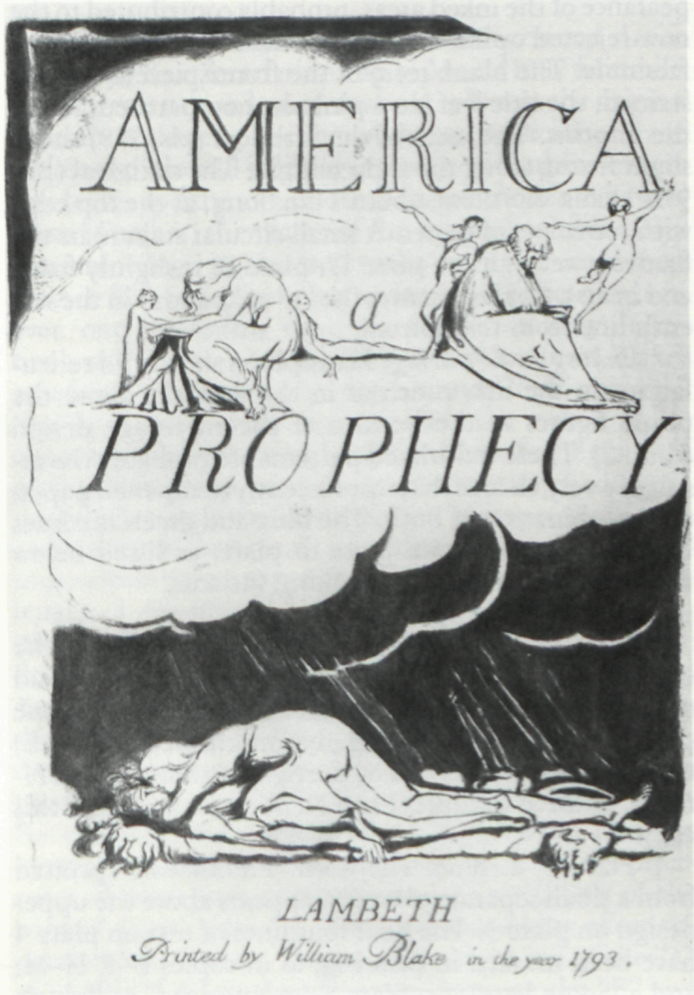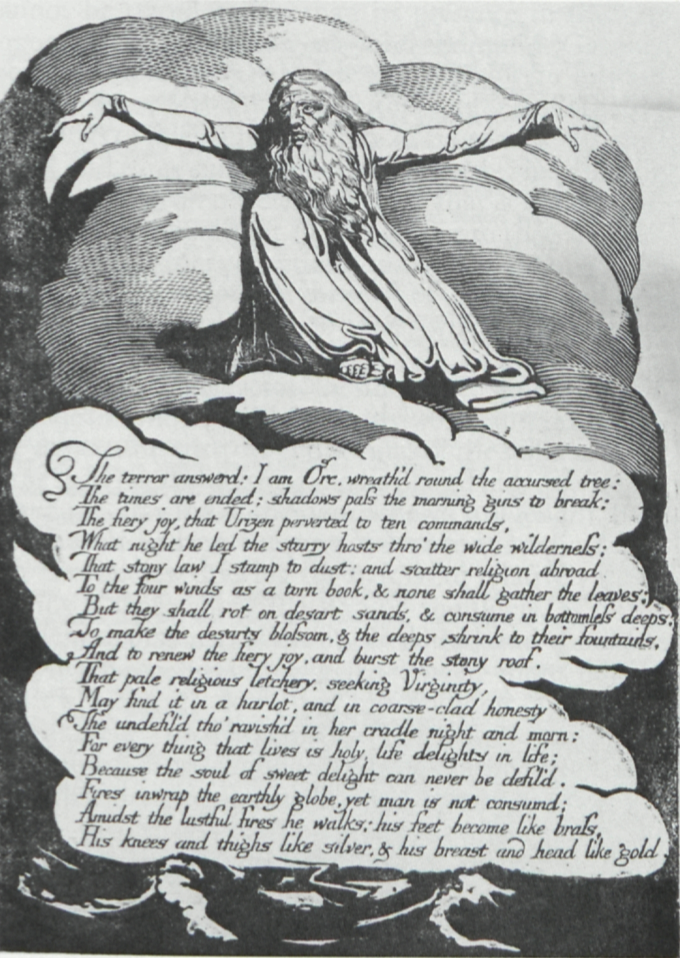MINUTE PARTICULARS
The Resurrection of America Copy R
Copy R of Blake’s America has been known for many years only through fragmentary accounts in sale catalogues and the more direct but dubious evidence offered by William Muir’s facsimile. The original volume came to light in 1987, precisely one hundred years after the publication of Muir’s lithographic imitation and, according to Blake Books, its last recorded appearance in the marketplace.1↤ 1 G. E. Bentley, Jr., Blake Books (Oxford: Clarendon Press, 1977) 106. Plate numbers and copy designations follow Bentley’s enumerations. The return of copy R to public notice permits a more accurate description of its characteristics and its history of ownership than has heretofore been available in the literature on Blake’s illuminated books.
The volume in question was consigned by a Philadelphia collector for auction by Christie’s New York in the summer of 1987. Christie’s and one of its bibliographic consultants at first believed the book to be a lithographic facsimile. Seeking another opinion, the auction house sent the book by air express to Thomas V. Lange, Associate Curator of Rare Books at the Huntington Library, San Marino, California. Some years ago, Lange discovered the two lithographic plates in America copy B (Pierpont Morgan Library, New York), thereby demonstrating his considerable expertise at discriminating between Blake’s originals and forgeries or facsimiles.2↤ 2 See Lange, “Two Forged Plates in America, copy B,” and Joseph Viscomi, “Facsimile or Forgery? An Examination of America, Plates 4 and 9, Copy B,” Blake: An Illustrated Quarterly 16 (1983): 212-23. Lange immediately recognized the volume as an original illuminated book printed by Blake. Thanks to Lange’s generosity, and the kind permission of Stephen Massey and Chris Coover of Christie’s Book Department, I was allowed to inspect the book while it was at the Huntington.
I base my identification of the rediscovered America as copy R on its relationship to Muir’s 1887 facsimile. The latter is printed on rectos only, whereas the original contains eighteen plates on ten leaves, with plates 1 and 2 (frontispiece and title page) facing each other on separate leaves and the remainder of the plates printed recto/verso.3↤ 3 Bentley, apparently relying on the facsimile, describes copy R as eighteen plates on eighteen leaves (89). Further, the plates of the original exhibit a considerable range in blue and green ink colors, and these are not followed closely in the facsimile. There is, however, one convincing type of evidence linking Blake’s book and Muir’s. Almost all impressions from Blake’s relief-etched copperplates have some “foul” inking—that is, droplets or smudges of ink in the etched whites or on incompletely wiped relief borders. Some patterns of foul inking appear on more than one impression of a single plate, but the vast majority of impressions have some unique features. It would be almost a statistical impossibility for two copies of an illuminated book the length of America to have the same accidental ink deposits throughout all their impressions. Muir’s facsimile does not reproduce every tiny droplet in the rediscovered America, but more than enough smudges and dots are shared by the two works to make it virtually certain that the original is the prototype Muir used for his partly photographic, partly hand-drawn, lithographic copy. For example, the original frontispiece (illus. 1) shows some rather messy over-inking that clogs the white interstices of black-line crosshatching just to the left of the winged giant’s right leg. A very similar inking effect appears in Muir’s work. The smudges to the left of the “A” of “AMERICA” on the title page, between the “E” and the “R,” and most other ink deposits visible in illus. 2 are captured by Muir (see illus. 3). He also reproduces the shadow lines of foul inking just inside the white cloud bearing the text on plate 10 (illus. 4).
begin page 139 | ↑ back to topThe basic physical features of America copy R can be most conveniently set forth under the following specific headings.
Plate States: Plate 13 is in the second state, with only one tail on the serpent, as in copies A-D, H, M-Q. All other plates are in the published states appearing in all other complete copies.
Paper: Ten leaves of wove paper trimmed to 36.4 × 25.5 cm. The fifth leaf, bearing plates 7 and 8, shows the watermark “E & P” lower left (when viewed from the recto). Blake used this paper, manufactured by Edmeads and Pine, in at least twenty other copies of his illuminated books, including seven other copies of America (C-E, G-K [there is no J]). The leaves were cleaned in this century (see Provenance, below) and apparently dried under heavy pressure. As a result, there is no indication of the light platemarks almost always present in unwashed impressions of Blake’s relief plates. The absence of these slight indentations, and the rather flat appearance of the inked areas, probably contributed to the now-rejected opinion that the volume is a lithographic facsimile. The blank recto of the frontispiece is slightly stained; the title leaf has a pinhole, now patched, left of the imprint. The recto of the fifth leaf (pls. 7/8) shows slight foxing along the right margin. The sixth leaf (pls. 9/10) has a short tear, about 1 cm. long, at the top edge with some loss of paper. A small circular stain mars the flames lower right on plate 17; plate 18 is slightly foxed and bears a small stain over the “s” of “bands” in the seventh line from the bottom.
Inking and Printing: Many plates show bold reticulations in the ink, much as in the dark sky above the prone figures at the bottom of the title-page design (illus. 2). These maculated patterns are probably the result of a very viscous ink, insufficiently dampened paper, or a combination of both. The blue and green ink hues vary considerably from plate to plate, as listed below with other information on inking variants.
Plate 1 (illus. 1). Blue.
Plate 2 (illus. 2.). Blue. The top left corner of the etched border and the dark sky between it and the cloud outline are printed with no evidence of wiping. In some copies, this area is partly (e.g., N) or completely (e.g., E) uninked. The border left of the figures above “PROPHECY,” printed in copies I and N, does not appear in this copy.
Plates 3-8. Blue. The word “Preludium,” printed from a small separate plate (e), appears above the upper design on plate 3. The final four lines of text on plate 4 have been masked in printing, as in copies B-F, H-M, and a. Some letters on plate 5 are smudged, as though the plate moved slightly in the press, and streaks in etched whites suggest an attempt to wipe away foul inking.
Plate 9. Bluish-green tending toward olive along the lower edge of the image.
Plate 10 (illus. 4). Dark olive green.
Plates 11-12. Light blue. Plate 11 (illus. 5) is lightly inked and has several printing flaws in the hatched areas, lower left.
Plate 13. Blue, with over-inked patches in the dark sky.
Plate 14. Blue-green.
Plate 15. Blue.
Plate 16. Light blue.
Plate 17. Light blue-green.
Plate 18. Light green.
A few plates show small black ink spots, perhaps offset or rubbed off from another print when still damp. begin page 140 | ↑ back to top The final plate bears several of these black, clustered spots, very similar to those on the same plate in copy I (Huntington Library).
The variety of ink colors strongly suggests printing “per-plate,” not “per-copy.” By the former term I mean the pulling of multiple impressions of the same plate, each printed with the same batch of ink. Other plates were inked with other ink batches which, in some cases, did not closely match those used for other plates. Evidence for this mode of production is also provided by the existence of multiple copies with more-or-less the same ink color; for example, copies C-G, I-L, all described by Bentley as having at least some plates printed in “greenish-Black” (88). Plate 10 in copy R was probably printed in the same press-run with these other greenish-black or olive impressions. Thus, copy R would appear to be a composite of at least three press-runs: blue, olive, and blue-green. In the early 1790s, Blake took multiple impressions of each illuminated-book plate in anticipation of multiple sales. When these did not materialize, he changed in the later 1790s to per-copy printing of each copy of an illuminated book as a unit, taking only one impression from each plate to create a single volume.
Binding: Modern plum-red morocco by Sangorski & Sutcliffe, elaborately gilt tooled and with green and black morocco inlays. Stamped in gilt on the upper front cover, “AMERICA/ A PROPHECY/ WILLIAM BLAKE.” Stamped in gilt on the spine, “AMER-/ ICA,/ A/ PROP-/ HECY/ . . ./ WILL-/ IAM/ BLAKE.” Housed in a green cloth folding box, lettered in gilt on the spine, “AMERICA/ A/ PROPHECY/ -/ WILLIAM/ BLAKE.” The front free endpaper is followed by three fly-leaves, the first of which bears the armorial bookplate of Christine Alexander Graham and (below) a clipping of lot 18 from the 1911 Anderson auction catalogue (see Provenance, below). The three front fly-leaves and the three at the end of the volume are variously watermarked “MBM,” “Ingres,” and “France.” The plates are bound consecutively in order, 1 through 18. Foliated in pencil, probably by a binder, 1-10, top right of rectos (including the blank recto of the frontispiece facing the title page). Another pencil number on leaf 8 recto (pl. 13) has been partly erased and is illegible. There is also fragmentary evidence of a pencil inscription, almost completely erased, on the blank verso of the title page. A pencil squiggle below might be the number 2 or 7. None of these pencil inscriptions can be attributed to Blake.
Hand Tinting: This copy is properly described as uncolored,4↤ 4 Bentley (89) indicates that copy R “is water-coloured by Blake or by his wife” and includes notes on its coloring in his plate by plate descriptions. The error apparently resulted from confusing Muir’s monochrome facsimile of copy R with his colored facsimile, printed from the same lithographic plates but tinted in imitation of copy A. but it does show a limited amount of tinting in the colors of the printing inks, probably executed to compensate for poor printing of small details. The hand tinting I have definitely identified as such is as follows:
Plate 3. Branch upper right, both ends of the worm at the bottom, and part of the vegetation below the bound youth above the text painted in by hand.
Plate 5. Some hand work in blue on the letters of “PROPHECY.”
Plate 8. Hand tinting along the outline of the skull and on both shoulders of the seated man.
Christie’s 1987 auction catalogue (see Provenance, below) includes notes on several other spots of hand tinting. I am less certain of these, except for some strengthening of letters in the text, but the catalogue descriptions deserve recording here:
Plate 3. “Lightly strengthened in pen and ink by Blake in . . . the figures at top . . . and the calligraphic verses.”
Plate 4. “Lightly strengthened . . . in a few places (several letters in the verses, the tree roots at bottom).”
Plate 6. “Lightly strengthened . . . in a number of places (the nose of the wyvern, many of the initial capitals in the calligraphic verses, the rocks at bottom).”
Plate 7. “Lightly strengthened . . . in a few places (the soaring figures’ flowing hair, one leg of the right-hand figure).”
Plate 11. “Lightly strengthened . . . in a few places (a couple of the initial capitals in the calligraphic verses, a few other letters).”
Plate 12. “Lightly strengthened . . . in a very few places (several flame tongues at far right center, tail of one letter of calligraphic verses).”
Plate 16. “Lightly strengthened . . . in several places (the clouds and extended fingers of right-hand figure, a few letters in the calligraphic verses).”
Provenance: The first published reference to the volume is its appearance in the catalogue for the London auction of works from the collection of George Smith, Christie’s, 1 April 1880, lot 164 (£31.10s. to the book-dealer Bernard Quaritch).5↤ 5 Bentley (106) where the only other recorded stage in the sales history of the volume is its appearance in Quaritch’s 1887 catalogue. Quaritch offered the book for sale in his advertising flyer of two leaves, entitled William Blake’s Original Drawings and dated May 1885. On page 2, without an item number, copy R is briefly described as “18 designs [i.e., plates] printed in blue, half bound green morocco, gilt edges,” and priced at £36. The same entry appears in Quaritch’s reissue of the flyer, dated November 1886. This advertisement also notes (page 4) that Muir’s facsimile of America is “in preparation.” Copy R next appears in Quaritch’s General Catalogue of Books, 1887, item 10,251, with the same description and price as the earlier flyers. The entry is repeated for a final time in Quaritch’s catalogue of February 1891, item 93. The volume was probably sold before January 1895, for it is not included in the extensive Blake offerings in Quaritch’s catalogue of that date. The purchaser was the great Blake collector William A. White of Brooklyn, New York, who also owned uncolored copy E and colored copy M of America. White lent copy R anonymously to the Grolier Club exhibition of 1905, no. 18 in the catalogue. The book is there described as “trimmed” to “14½ × 10⅛ inches” (36.8 × 25.7 cm.—just a few millimeters larger than the present dimensions), “printed in blue ink,” watermarked “E P” (i.e., E & P), and “bound” and “gilt.” Copy R changed hands when it was sold in New York “from the important Private Library of a Brooklyn Collector” (no doubt White), Anderson Auction Company, 27 October 1911, lot 18, “half dark green morocco, gilt edges” ($625, according to a priced copy of the catalogue in the Huntington Library). The auction catalogue includes a reproduction of the America title page. The patterns of foul inking in this plate clearly identify the volume in the auction as copy R, and thus provide the best evidence for its earlier ownership by White. This illustration also reveals a large stain below the “O” of “PROPHECY,” now no longer present. The plate must have been cleaned sometime after 1911. Since the title page is on paper of
I have found no record of the book’s purchaser at the 1911 auction, but either at the sale or soon thereafter it was acquired by Christine Alexander Graham of Maryland, who also owned copy A of Songs of Innocence between 1912 and 1943 (Bentley, 404). Copy R was very probably cleaned, slightly cut down (thereby removing the gilt edges), and rebound by Sangorski & Sutcliffe shortly after the 1911 auction. The volume passed by inheritance to the late Margaret M. Sullivan of Philadelphia. Her brother, acting on behalf of Sullivan’s estate, brought copy R to Christie’s in 1987.
Christie’s New York placed the book in its auction of 13 November 1987, lot 46. The very detailed and accurate description in the catalogue is accompanied by color reproductions of the frontispiece, title page, and plate begin page 142 | ↑ back to top
The provenance of America copy R affects the previously recorded history of copy D, now at Princeton University. Bentley (101), citing “Keynes & Wolf” as his authority,7↤ 7 Geoffrey Keynes and Edwin Wolf 2nd, William Blake’s Illuminated Books: A Census (New York: Grolier Club, 1953) 45. states that copy D was acquired by W. A. White “in 1891,” lent to the Grolier Club’s 1905 exhibition, no. 18, and sold at Anderson’s on 27 October 1911, lot 18. Since this last point is demonstrably not true, and since copy R was lot 18 in the 1911 auction, there is no documentary evidence that White ever owned copy D. Unless Keynes and Wolf had some (unstated) evidence about White’s purchase of the book in 1891, we are left with a gap in the provenance of copy D between its sale at Sotheby’s London in 1888 and its sale from the Cortlandt Bishop collection at the American Art Association, New York, in 1938.
The at least temporary resurrection of America copy R is a most satisfying event in the recovery of Blake’s artistic legacy. It gives one hope that other treasures may someday arise from the caverns of history’s grave and find again an appreciative audience.





